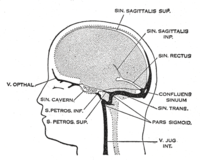
Photo from wikipedia
Background: Pilonidal disease (PD) represents one of the most common proctological diseases in young adults. Although several approaches to treating PD have been described, there is still a lack of… Click to show full abstract
Background: Pilonidal disease (PD) represents one of the most common proctological diseases in young adults. Although several approaches to treating PD have been described, there is still a lack of agreement on which is the best. The aim of this study was to evaluate the long-term efficacy of endoscopic pilonidal sinus treatment (EPSiT) at a tertiary care academic center. Methods: Between June 2017 and January 2021, a total of 32 patients [12 women (37.5%) and 20 men (62.5%)] with a mean age of 29.22 ± 12.98 years were treated with EPSiT. Pre- and post-operative symptoms were assessed with a score of 0–5. Success was defined as the absence of any subjective symptoms, as well as by complete post-operative wound healing. Results: Most of the patients had a midline external opening (17/32; 53.1%), with a mean number of external openings of 2.41 (1–4) ± 1.04. The median post-operative pain score was 0, and the mean follow-up period was 22 (4–42) ± 11.49 months. The time to wound healing was reduced in patients with one opening (28.14 ± 4.06 days) compared to patients with two or more openings (33.64 ± 7.3 days) (p = 0.067). The mean operative time was longer in patients who subsequently had a recurrence (41.75 ± 6.24 vs. 34.18 ± 6.24 min; p = 0.031). The overall success rate was 87.5% (28/32), and the mean time to recurrence was 3.25 (2–5) ± 1.26 months. Conclusions: EPSiT represents a viable option for the treatment of PD. More evidence and a longer follow-up period are needed to validate the results.
Journal Title: Frontiers in Surgery
Year Published: 2021
Link to full text (if available)
Share on Social Media: Sign Up to like & get
recommendations!